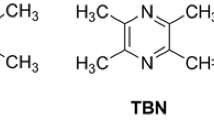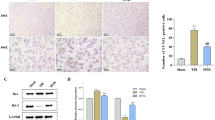Abstract
Nicotinamide adenine dinucleotide (NAD+) plays critical roles in energy metabolism, mitochondrial functions, calcium homeostasis and immunological functions. Our previous studies have found that NAD+ administration can profoundly decrease ischemic brain injury and traumatic brain injury. Our recent study has also provided first direct evidence indicating that NAD+ treatment can decrease cellular apoptosis, while the mechanisms underlying this protective effect remain unclear. In our current study, we determined the effects of NAD+ treatment on several major factors in apoptosis and necrosis, including levels of Bax and nuclear translocation of apoptosis-inducing factor (AIF), as well as levels of DNA double-strand breaks (DSBs) and intracellular ATP in rotenone-treated differentiated PC12 cells. We found that NAD+ treatment can markedly attenuate the rotenone-induced increases in the levels of Bax and nuclear translocation of AIF in the cells. We further found that NAD+ treatment can significantly attenuate the rotenone-induced increase in the levels of DSBs and decrease in the intracellular ATP levels. Collectively, our study has suggested mechanisms underlying the preventive effects of NAD+ on apoptosis, which has highlighted the therapeutic potential of NAD+ for decreasing apoptotic changes in multiple major diseases.




Similar content being viewed by others
References
Ying W (2008) NAD+/NADH and NADP+/NADPH in cellular functions and cell death: regulation and biological consequences. Antioxid Redox Signal 10(2):179–206. doi:10.1089/ars.2007.1672
Alano CC, Garnier P, Ying W, Higashi Y, Kauppinen TM, Swanson RA (2010) NAD+ depletion is necessary and sufficient for poly (ADP-ribose) polymerase-1-mediated neuronal death. J Neurosci 30(8):2967–2978
Alano CC, Ying W, Swanson RA (2004) Poly (ADP-ribose) polymerase-1-mediated cell death in astrocytes requires NAD+ depletion and mitochondrial permeability transition. J Biol Chem 279(18):18895–18902
Ying W, Garnier P, Swanson RA (2003) NAD+ repletion prevents PARP-1-induced glycolytic blockade and cell death in cultured mouse astrocytes. Biochem Biophys Res Commun 308(4):809–813
Won SJ, Choi BY, Yoo BH, Sohn M, Ying W, Swanson RA, Suh SW (2012) Prevention of traumatic brain injury-induced neuron death by intranasal delivery of nicotinamide adenine dinucleotide. J Neurotrauma 29(7):1401–1409
Ying W, Wei G, Wang D, Wang Q, Tang X, Shi J, Zhang P, Lu H (2006) Intranasal administration with NAD+ profoundly decreases brain injury in a rat model of transient focal ischemia. Front Biosci 12:2728–2734
Zheng C, Han J, Xia W, Shi S, Liu J, Ying W (2012) NAD+ administration decreases ischemic brain damage partially by blocking autophagy in a mouse model of brain ischemia. Neurosci Lett 512(2):67–71
Hong Y, Nie H, Wu D, Wei X, Ding X, Ying W (2014) NAD+ treatment prevents rotenone-induced apoptosis and necrosis of differentiated PC12 cells. Neurosci Lett 560:46–50. doi:10.1016/j.neulet.2013.11.039
Esposito E, Cuzzocrea S (2010) New therapeutic strategy for Parkinsons and Alzheimers disease. Curr Med Chem 17(25):2764–2774
Borutaite V (2010) Mitochondria as decision-makers in cell death. Environ Mol Mutagen 51(5):406–416. doi:10.1002/em.20564
Greenamyre JT, Betarbet R, Sherer TB (2003) The rotenone model of Parkinson’s disease: genes, environment and mitochondria. Parkinsonism Relat Disord 9:59–64
Kristal BS, Stavrovskaya IG, Narayanan MV, Krasnikov BF, Brown AM, Beal MF, Friedlander RM (2004) The mitochondrial permeability transition as a target for neuroprotection. J Bioenerg Biomembr 36(4):309–312
Greenamyre JT, Betarbet R, Sherer TB (2003) The rotenone model of Parkinson’s disease: genes, environment and mitochondria. Parkinsonism Relat Disord 9(Suppl 2):S59–S64
Jang SJ, Ham MS, Lee JM, Chung SK, Lee HJ, Kim JH, Chang HC, Lee JH, Chung DK (2003) New integration vector using a cellulase gene as a screening marker for Lactobacillus. FEMS Microbiol Lett 224(2):191–195
Cande C, Cecconi F, Dessen P, Kroemer G (2002) Apoptosis-inducing factor (AIF): key to the conserved caspase-independent pathways of cell death? J Cell Sci 115(Pt 24):4727–4734
Marella M, Seo BB, Matsuno-Yagi A, Yagi T (2007) Mechanism of cell death caused by complex I defects in a rat dopaminergic cell line. J Biol Chem 282(33):24146–24156
Wang S, Xing Z, Vosler PS, Yin H, Li W, Zhang F, Signore AP, Stetler RA, Gao Y, Chen J (2008) Cellular NAD replenishment confers marked neuroprotection against ischemic cell death role of enhanced DNA repair. Stroke 39(9):2587–2595
Chung DH, Im Lee J, Kook MC, Kim JR, Kim SH, Choi EY, Park SH, Song HG (1998) ILK (β1-integrin-linked protein kinase): a novel immunohistochemical marker for Ewing’s sarcoma and primitive neuroectodermal tumour. Virchows Arch 433(2):113–117
Sheng C, Chen H, Wang B, Liu T, Hong Y, Shao J, He X, Ma Y, Nie H, Liu N, Xia W, Ying W (2012) NAD+ administration significantly attenuates synchrotron radiation X-ray-induced DNA damage and structural alterations of rodent testes. Int J Physiol Pathophysiol Pharmacol 4(1):1–9
Chung Y, Eu KW, Machin D, Ho J, Nyam D, Leong A, Ho Y, Seow-Choen F (1998) Young age is not a poor prognostic marker in colorectal cancer. Br J Surg 85(9):1255–1259
Yamada Y, Coffman CR (2005) DNA damage-induced programmed cell death: potential roles in germ cell development. Ann N Y Acad Sci 1049(1):9–16
Eguchi Y, Shimizu S, Tsujimoto Y (1997) Intracellular ATP levels determine cell death fate by apoptosis or necrosis. Cancer Res 57(10):1835–1840
Stryer L (1995) Biochemistry. Freeman and Company, New York
Greenamyre JT, MacKenzie G, Peng TI, Stephans SE (1999) Mitochondrial dysfunction in Parkinson's disease. Biochem Soc Symp 66(1):85–97
Acknowledgments
This study was supported by Chinese National Science Foundation Grants #81171098 and #81271305 (to W. Y.), and two Shanghai Jiao Tong University Grants for Interdisciplinary Research on Medicine and Engineering (to W. Y.).
Author information
Authors and Affiliations
Corresponding author
Electronic supplementary material
Below is the link to the electronic supplementary material.
Rights and permissions
About this article
Cite this article
Hong, Y., Nie, H., Wei, X. et al. NAD+ Treatment Can Prevent Rotenone-Induced Increases in DNA Damage, Bax Levels and Nuclear Translocation of Apoptosis-Inducing Factor in Differentiated PC12 Cells. Neurochem Res 40, 837–842 (2015). https://doi.org/10.1007/s11064-015-1534-0
Received:
Revised:
Accepted:
Published:
Issue Date:
DOI: https://doi.org/10.1007/s11064-015-1534-0




